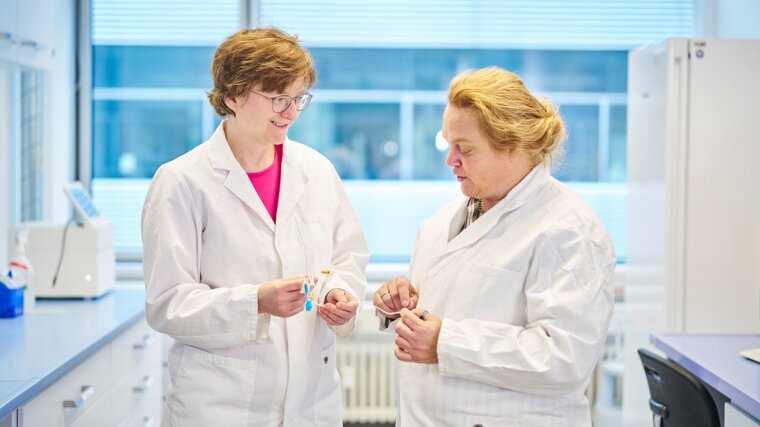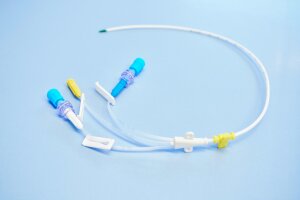
The relevance of mathematical models extends far beyond the world of science—a fact made abundantly clear by the COVID-19 pandemic. Such models helped to forecast the spread of the virus, optimize vaccination strategies and assess containment measures. However, such models also have many other applications. In moder medicine, for example, they play a decisive role in understanding biological processes and help to improve clinical decisions. In her work in the Cluster of Excellence »Balance of the Microverse«, Prof. Dr Rosalind Allen deploys mathematical and biophysical models to investigate bacterial infections in urinary catheters.
By Juliane Seeber
Urinary catheters are essential pieces of healthcare equipment, especially in hospitals and care facilities. But while millions of these catheters are used every year, their use also entails certain risks. Catheter-associated urinary tract infections (UTIs) are among the most common hospital-acquired infections and can cause serious complications, including damage to the bladder or kidneys. Despite decades of research, we still lack a complete understanding of the mechanisms that lead to bacterial colonization of catheters. Rosalind Allen and her interdisciplinary team are now tackling this problem with a novel approach.
The research team have developed a mathematical model that describes different routes of infection and the dynamics of bacterial colonization. Their approach combines the outer surfaces of the catheter, the bladder, the flow of urine within the catheter and the inside surfaces of the catheter together in a single, integrative model. Simulations have enabled the researchers to identify key factors that influence the risk and progression of infections.
Their model shows that the urine production rate—determined by the patient’s fluid intake—plays a central role. Increased fluid intake makes it possible to flush out bacteria in the urine more effectively, therefore reducing the risk of an infection. For short term catheterisation, however, the risk of infection is determined by the length of the catheter and the speed at which bacteria spread over the surface of the catheter.
Close-up of a urinary catheter on a light blue background
Image: Anna SchrollFrom research to clinical practice
This research into catheter infections is a prime example of how theoretical models can be applied to solve practical problems. »Our models enable us to better understand the underlying mechanisms and develop targeted prevention strategies,« says Rosalind Allen. As she explains, this research demonstrates why antibacterial coatings on catheters may only be effective for short-term catheterisation, and highlights how factors such as the patient’s sex and fluid intake influence the risk of infection.
The results of Allen’s team research hold direct practical relevance. For for long-term catheterisation, targeted measures to increase the patient’s fluid intake can reduce their risk of infection. By contrast, for short-term catheterisation, antibacterial coatings can help to slow the spread of bacteria along the surface of the catheter. This research also underscores the importance of personalized strategies to meet the different needs and risks of individual patients.
Mathematical modelling continues to develop rapidly in microbiology and infection medicine, highlighting its potential in fields far beyond its traditional use in pandemic control. The Allen group's research shoes how models can be applied to complex microbial systems to facilitate targeted interventions.
A glimpse of the future
In the Cluster of Excellence »Balance of the Microverse«, Allen's group is working to refine innovative approaches, with some deployed in other studies. For example, her group is also working on a project to understand the microbial colonization of biliary drainage catheters, central venous catheters and breathing tubes. In collaboration with other Jena-based researchers, and led by the group's lab leader Dr Anne Busch, the research group has demonstrated a mechanism for targeted activation of antibiotics using light. This technique could help to reduce the bacterial colonization of biliary drainage catheters and overcome the issue of antimicrobial resistance.
The Theoretical Microbial Ecology research group have demonstrated the importance of mathematical models—not only to better understand the mechanisms of infections but also to promote the future development of new, specific treatment methods.
Innovation for medicine and therapy
Mathematical models, combined with experiments and knowledge from a variety of subject areas, open up new avenues to prevent and treat diseases more effectively. Additionally, research into special antibiotics that are activated by light demonstrates the potential for wholly novel treatment approaches, not only in fighting infections but also in cancer medicine and tissue healing. This opens the door to solutions tailored precisely to patients’ needs. These solutions could enhance patients’ quality of life while also increasing the efficacy of medical care.
Original publications:
Different factors control long-term versus short-term outcomes for bacterial colonisation of a urinary catheter, BioRXiv, 2025; https://doi.org/10.1101/2022.10.31.514508External link
The effects of photoactivated ciprofloxacin and bile acids on biofilms on bile duct catheters, Internationa Journal of Antimicrobial Agents, 2024; https://doi.org/10.1016/j.ijantimicag.2024.107086External link
07743 Jena Google Maps site planExternal link
